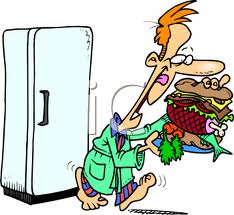
When it comes to eating healthfully, fresh fruits and vegetables are pretty much a slam dunk. Including packaged foods in a healthful diet is trickier. But it isn’t impossible if you learn how to use the Nutrition Facts on the package to judge the quality of the food inside. The vitamin or mineral content is less important as a basis for buying a product unless everything else adds up to a healthy choice.
Size matters. Serving size is always the first item on the label. All other information is based on that serving size. The servings per container tell you know how many portions are in the whole box, package, or can. Beware: many packages contain more than one serving. Look at your orange juice for example. If the label says 125 calories per 8 ounce serving and your breakfast includes a 16 ounce glass of OJ, then you’ve taken in 250 calories from the juice alone. (About as many calories as you’d find in many chocolate bars.)
Look for fat: the good, the bad, and the really bad. Check the saturated fat and trans fat content of the food. For a general healthful diet, keep saturated fat and cholesterol low and avoid trans fats altogether. Look for foods that have 0 grams (g) of trans fat and are lowest in saturated fat and cholesterol. Try to stay away from foods that have the words “partially hydrogenated vegetable oil” in the ingredients list. Foods made with healthy unsaturated oils (olive, canola, safflower, etc.) are better bets.
Is it worth its salt? Compare the sodium content to the calories per serving. To keep your salt intake in check, consider products in which the sodium content is less than or equal to the calories per serving. For a food with 250 calories per serving, ideally the sodium content should be no more than 250 mg. If you need to seriously restrict your salt intake consider the low-sodium, low-salt, or unsalted versions.
Figure out the fiber. Aim for foods that have 5 g of fiber per serving, or at least one gram of fiber for every 10 grams of carbohydrate.
Stay away from added sugars: Sugar, no matter what it’s called, contains almost no nutrients other than pure carbohydrate. A heavy sugar intake fills you up with empty calories, keeps you from eating healthy foods, and stresses your body’s ability to maintain a healthy blood sugar level. Steer clear of foods that have sugar, honey, molasses, corn syrup, corn sugar, fructose, or high-fructose corn syrup among the first three ingredients. Other names for sugar include agave nectar, brown sugar, cane sugar, corn sweetener, dextrose, maltose, fruit juice concentrate, and glucose.
Go for the grain. Whole-grain snacks, such as whole-grain low-salt pretzels or tortilla chips and high-fiber, whole-grain cereals, can give you some energy with staying power.
Bring back breakfast. Many breakfast foods can be re purposed as a nutritious snack later in the day. How about a slice of whole-grain toast topped with low-sugar jam? Low-sugar granola also makes a quick snack.
Try a “hi-low” combination. Combine a small amount of something with healthy fat, like peanut butter, with a larger amount of something very light, like apple slices or celery sticks.
Go nuts. Unsalted nuts and seeds make a great snack. Almonds, walnuts, peanuts, roasted pumpkin seeds, cashews, hazelnuts, filberts, and others contain many beneficial nutrients and are more likely to leave you feeling full (unlike chips or pretzels). Nuts have lots of calories, though, so keep portion sizes small.
The combo snack. Try to eat more than one macronutrient (protein, fat, carbohydrate) at each snacking session. For example, have a few nuts (protein and fat) and some grapes (carbohydrates). Try some whole-grain crackers (carbohydrate) with some low-fat cheese (protein and fat). These balanced snacks tend to keep you feeling satisfied.
Snack mindfully. Don’t eat your snack while doing something else like surfing the Web, watching TV, or working at your desk. Instead, stop what you’re doing for a few minutes and eat your snack like you would a small meal.
You can take it with you. Think ahead and carry a small bag of healthful snacks in your pocket or purse so you won’t turn in desperation to the cookies at the coffee counter or the candy bars in the office vending machine.